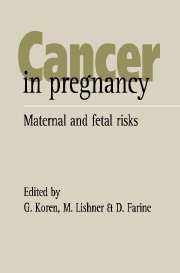Book contents
- Frontmatter
- Contents
- Preface
- List of contributors
- Part I Introduction
- 1 Cancer in pregnancy: identification of unanswered questions on maternal and fetal risks
- 2 The pregnant with malignant disease: maternal–fetal conflict
- 3 Changes in drug disposition during pregnancy and their clinical implications
- 4 The role of the placenta in the biotransformation of carcinogenic compounds
- 5 Antepartum fetal monitoring in the oncologic patient
- 6 The Toronto Study Group: methodological notes
- 7 Motherisk: the process of counselling in reproductive toxicology
- Part II Specific tumors during pregnancy
- Part III Fetal effects of cancer and its treatment
- Index
5 - Antepartum fetal monitoring in the oncologic patient
from Part I - Introduction
Published online by Cambridge University Press: 06 July 2010
- Frontmatter
- Contents
- Preface
- List of contributors
- Part I Introduction
- 1 Cancer in pregnancy: identification of unanswered questions on maternal and fetal risks
- 2 The pregnant with malignant disease: maternal–fetal conflict
- 3 Changes in drug disposition during pregnancy and their clinical implications
- 4 The role of the placenta in the biotransformation of carcinogenic compounds
- 5 Antepartum fetal monitoring in the oncologic patient
- 6 The Toronto Study Group: methodological notes
- 7 Motherisk: the process of counselling in reproductive toxicology
- Part II Specific tumors during pregnancy
- Part III Fetal effects of cancer and its treatment
- Index
Summary
Introduction
In this chapter we consider fetal monitoring in pregnancies in women with cancer where a decision has been made to continue the pregnancy to the third trimester to achieve fetal viability. These cases are beyond the “dilemma phase” of the first and second trimester. The general principles of fetal monitoring would apply also to pregnancies where the malignancy is in the fetus, but the specific management of such cases is discussed elsewhere. This chapter serves as a brief overview of fetal monitoring, not for the perinatologist but for health care professionals from the other disciplines involved in the management of such patients.
These pregnancies are considered “high risk” because of the maternal condition, which may affect the fetus through the maternal systemic effects of malignancy (e.g., malnutrition and pyrexial illness), the effects of investigation and diagnosis (X-ray, thyroid radionucleotide and bone scans), the effects of treatment (e.g., surgery, anesthesia, chemotherapy, radiotherapy, hormonal therapy and analgesia), or direct effects of the maternal tumor on the fetus by the hormone secretion and, rarely, trans-placental metastasis.
Fetal lung maturity is usually expected after the 34th week of pregnancy in the majority of babies (diabetic mothers' fetuses are an exception because of delayed fetal lung maturity), but the course of the disease in either mother or fetus may necessitate earlier delivery before lung maturity has been achieved.
- Type
- Chapter
- Information
- Cancer in PregnancyMaternal and Fetal Risks, pp. 53 - 68Publisher: Cambridge University PressPrint publication year: 1996

